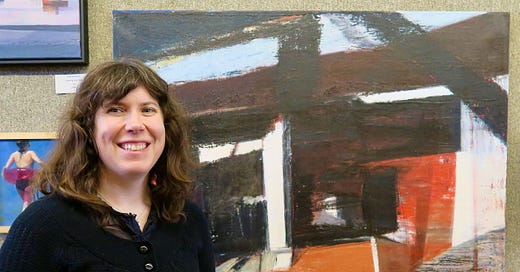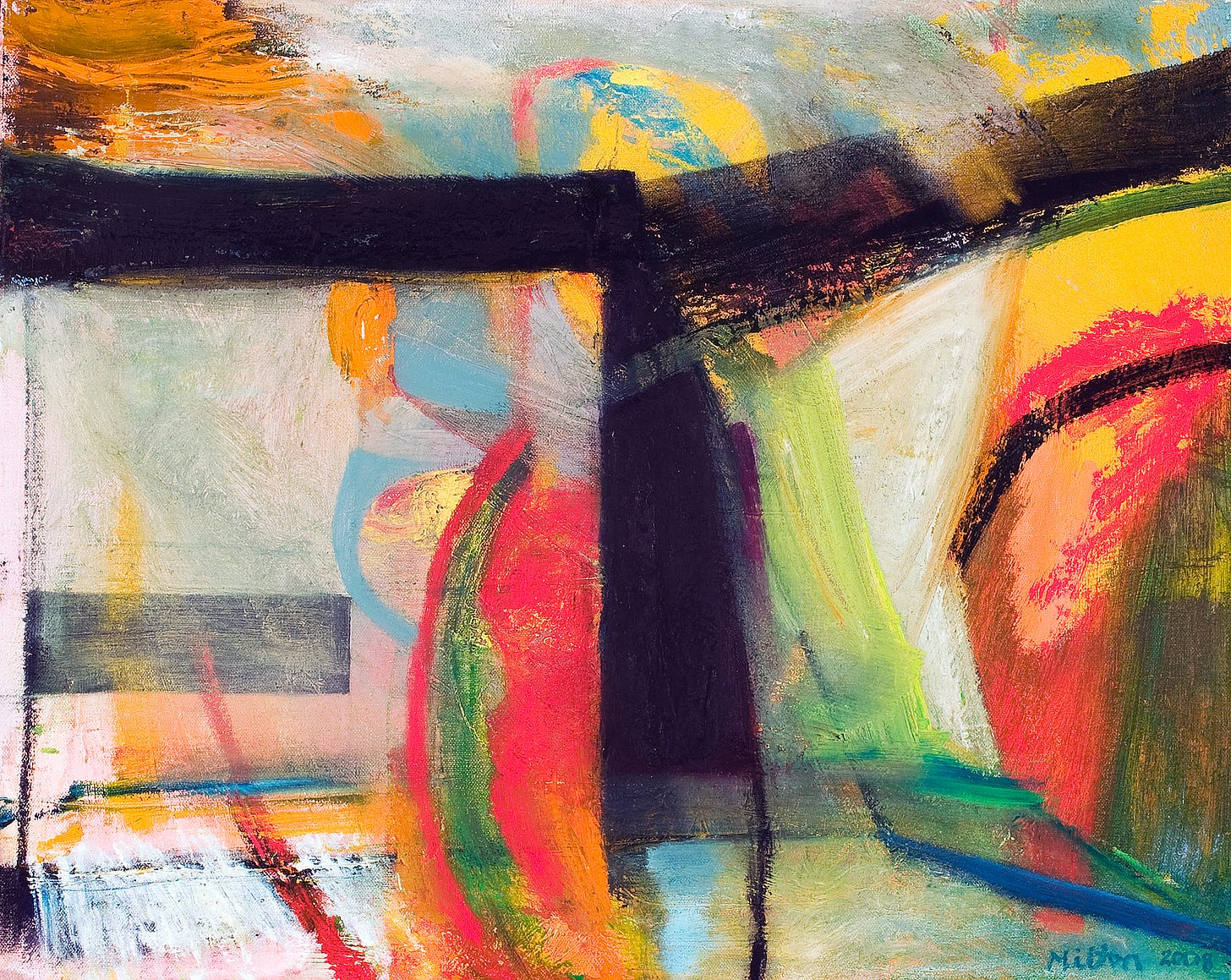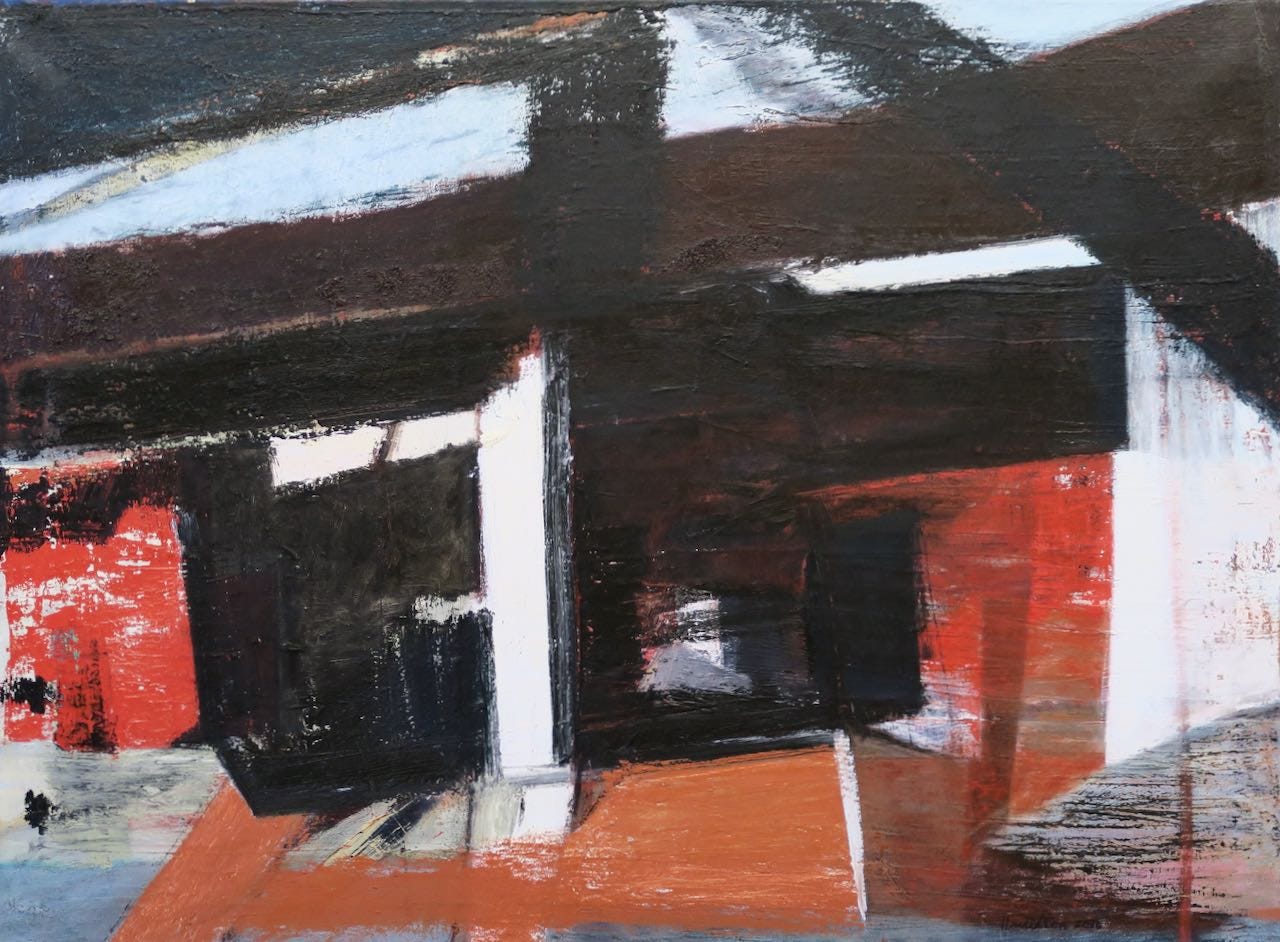Sarah LL Milton, abstract painter and gallery director
Finding art materials in unexpected places, painting abstract art from real life, and how a youth spent in rural Vermont led to Harvard.
Sarah Milton is the gallery director at North Shore Arts Association, where she curates exhibits and thrives on collaborating with artist members, staff, board members, and community organizations. She also makes striking abstract paintings inspired by desolate places that she loves.
Get into a conversation with Sarah about art materials, a topic she is passionate about, and you might be inspired to roam the aisles of your local art supply store or look around for unconventional materials or mediums you can turn into artworks. Below she describes how she did exactly that to create the painting behind her in the photo above.
Tell me about your art path.
I grew up in a small town in Vermont on a dirt road. I started drawing like every child does, dragons and parrots, and I would perfect them with colored pencil. I kept drawing. In high school, I took every art class possible, which wasn’t much, so then I took woodshop and started building furniture and that led to picture frames. I still build furniture and I built or designed most of the furniture in my house.
I went to Montserrat College of Art, where I was able to expand, undo everything I knew, and absorb so much history, museums, culture, and life. That led to me continuing on with art and creating a core family of artists around me. I worked at Pearl Art and Craft, hardware stores, Utrecht Art Supplies, Big Picture Framing, and Artist & Craftsman Supply.
How were your jobs at hardware stores and art supply stores formative for your art?
I can clearly see how everything led to where I am today. At the hardware store, I mixed housepaint and got my hands on different nails and materials you wouldn’t have at an art store. It also introduced me to spray paint and I started playing with that in my paintings. Working at art supply stores exposed me to so many different types of paint and other materials. We had to know how the materials worked so we used them and saw demonstrations from many of the paint companies.
Who was instrumental in your development as an artist?
Mr. Eddie, my high school art teacher. It only occurred to me now that I’ve never seen a single piece of his art in my entire life! I wasn’t planning to go to college or leave Vermont. He thought I should and gave me a handwritten list of 10 colleges. I wish I kept it. He said please pick three and go see them. My mom, my grandmother, and I got in a car and checked out Maine College of Art & Design in Portland, School of the Museum of Fine Arts, and Montserrat College of Art, which is where I ended up.
How did you end up doing museum work?
It was just a matter of time before I ventured into museums. In 2004, I started working at the Harvard Art Museums in collections management, monitoring the condition of the artwork and working with conservators. I had such an extensive background in materials that I knew by looking at something what it was made of and if that material was breaking down.
That led to me becoming an employee of what is now the Harvard Museum of the Ancient Near East. I came on first as a student, then a volunteer, then a staff member, and now I’ve continued on as a contractor. I started there on an exhibit From Stone to Silicone: Recasting Mesopotamian Monuments, which was already underway when I joined. I developed a painting system for replicas of ancient Mesopotamian walls, which depict battle scenes from old palaces that don’t exist anymore. The original wall fragments are in the Louvre and in the British Museum.
How did you know how to create the painting system?
The project leader Dr. Adam Aja developed a system for building the replicas. When I came on as a student, I realized they didn’t know how to paint the molded walls to replicate the actual ones. They were these off-white yellowish acrylic resin casts and molds that were huge: 5 feet x 11 feet. They had some original pieces in the basement and I was able to replicate the color and teach the curator and interns how to do the same thing. Now the replicas are on display in a gallery and they look phenomenal. I was able to help bring the replicas to their final state because of my love of materials.
What came after that project?
I was working project by project and once a project is done, you had to find the next one. But, I needed something more in my life, so I went to Harvard to earn a master’s degree in museum studies. For three years I was working at Artist & Craftsman Supply in custom framing during the day and going to school at night.
That led to an internship at the Rockport Art Association and they hired me to be their manager of collections and exhibitions, which I did for five years. That led me to become the director of the North Shore Arts Association, where I now curate exhibits.
What is the most fun project you conceived and executed?
I painted a mural for the Boston Fire Department in Allston, Engine 41, Ladder 14 right after the Boston Marathon bombing. It’s a street scene at a huge cross-section area of Allston-Brighton with the city in the background. I worked closely with a team of firefighters to create this huge mural on the inside of their building. I got to know them, and rode in firetrucks and cooked dinners with them. The alarms would go off just as they were sitting down to dinner, so I would run around and put plastic on their plates until they could come back [laughs]. [See the mural in situ here.]
I think of you as an abstract painter, and the mural sounds representational.
I am an abstract painter, but I always work from life. It was cool to work in a way that was so outside of my comfort zone. It took me longer than I would like to admit because I was learning. I’d ask myself how do you paint that large? How do you paint it realistically?
What has been the most rewarding exhibition for you?
I had a solo show called “How it Looks from Here” at the HallSpace gallery in Dorchester. It was one of those experiences you read about in books when people sell most of their work, and it was well-received.
Tell me about “You Can’t Keep Vegas in a Box” [above].
It’s my mom’s favorite painting. My dad and grandparents lived in Vegas. I grew up going back and forth from Vermont to Vegas. With the casinos and desert, it had this dry, wild feeling like it couldn’t be tamed. It was a 24/7 city, so at 3 o’clock in the morning people were walking down the street holding beers. I tried to put it in a box and make sense out of it, but it was untamable.
Who are the artists you admire?
Many are representational, such as Renoir. I love his softness, and how his paint strokes are gestures. You get the distinct sense of the subject’s moving hand connected to the strokes.
Giacometti, a sculptor who did these amazing drawings of heads and bodies. You can see where he’s reworked and reworked them. Most artists want you to see the result as a perfected form, and not to see all the struggle that went into creating it. Giacometti’s sculptures and drawings show the entire process, and every mistake, and he embraced that. It made the final result, even a simple drawing, terrific.
Then there’s Diebenkorn, who I love. I didn’t find out about him until after I was painting the way I paint.
Do you have a core set of materials in your art studio? Are you always adding new materials?
I use different kinds of paints to get what I want. [Referring to brands of paint:] Rembrandt paints give me a thick look. Gamblin paints are smooth and they also have a transparent line. I’ve always lived in apartments with roommates or animals so I’ve never used turps or any kind of painting medium because of fire and health hazards. I use materials that do what I need in their purest form. That means mixing many different paints. If you looked at my palette you would see Holbein, Winsor, Gamblin, R&F, Sennelier, Williamsburg, Blockx. It’s not one or two kinds, it’s everything you could imagine.
Can you describe your process for making the painting that’s in the gallery now [see Northfield, VT, above]?
Years ago, I was camping and after fire went out there were remnants of the wood that had burned into huge chunks of charcoal. Usually you buy charcoal at stores, these perfect thin things that wear out fast, and here I had these big burnt pieces of wood that you needed two hands to hold. I thought, this is a lifetime supply of charcoal and the pieces are going to make really big marks. I gathered them up and brought them home.
This painting is of an old, abandoned barn in Northfield, Vermont. I try to go to places where no one else wants to go. You see the sky through the wood and the wood was burned. What better way to create this painting than to use the collected charcoal along with some paint!
I wondered what would happen if I took a transparent medium oil stick extender, and worked with that and the charcoal. The extender stick, which is painting medium in a stick form, helped the charcoal stay on the canvas, and the ash became the pigment, and I was able to approximate oil paint. Once that dried, I wiped on oil-based etching ink, which was very sticky, and it gave it a vibrant, transparent look. That’s why the reds look as bright as they do.
Have you used unconventional materials in other ways?
I created Autumn and After Arizona [see above] around the same time. I was using any materials I could get my hands on, and I found a futon skeleton, which had perfectly sanded slats with holes. I unscrewed the slats and reassembled them as stretcher bars. The paintings are wide and heavy, and 2-3 inches deep.
What’s it like being an abstract painter in the land of representational art that often depicts boats and harbor scenes?
It’s terrific. Everything I think about as an abstract artist, a representational artist thinks about: composition, balance, shape, color, push and pull, positive and negative, forward backward, materials, light.
I have a huge appreciation for representational work. If it’s done well, it feels right. When you see representational art done from a photograph it has this stillness. Those painted plein air have more feeling. [She confesses with a laugh] I’m a difficult person to please.
You are critical of your own art or other people’s art?
Both. People ask my opinion on art and I don’t give it. That’s to protect them and myself [laughs]. What I’m most proud of for an artist is their willingness to continue no matter what people say. I’ve had people try to get me to feel bad about my work. I don’t, because my work isn’t about them, and isn’t about getting confirmation or approval. Success is being able to make art, or think about art, or be involved in the arts in some way every single day.
Have you ever had a dry spell or felt uninspired? What do you do to get out of that?
When I was going through my master’s program at Harvard, it was three years being dedicated to working full time and doing schoolwork. My art definitely took a hit. I did what was manageable, such as making cards for family and friends. Also, I started fly fishing about five years ago and I tie my own flies. They are little three-dimensional sculptures with all these materials—feathers, leather, foam, hooks, and different glues and adhesives. It’s a different art form and they not only have to look beautiful, they have to work.
What’s the best advice you received as an artist?
It was from Chuck Ott, my advisor at Montserrat College my senior year. I was working from architecture. He asked me, “Sarah, why do you paint doorways and windows?” I said, “because I like them.” And he said, “that’s not enough.” He kept pushing me, asking, “why are you doing this?” I couldn’t pull it out of me and was getting frustrated. Finally, I said, “because you can go in and out of them, be trapped by them, or look out or look in.” He said, “Exactly. They are part of the human condition. There are all kinds of doors. There are the invisible doors. Then there are the ones that keep us in and out.”
This was a transition from just being able to paint what I think I like to going deeper and understanding the meaning behind it. But you don’t always process it when you are making art, sometimes it’s a blank. I call it a time warp. You don’t eat, you don’t pee, the world could be falling apart but you don’t know because you are in this zone.
What’s the worst advice you received?
It was from my mother [laughs]. I love her. I had a friend who was a difficult person and didn’t have a lot of friends. My mom said maybe I’m the person who can show him what a friend is. I learned there are certain people you’re not meant to be friends with. I tie that to art: If you are making art that doesn’t feel right, it’s not enjoyable, and you’d rather spend time doing something else, then do something else.
Sometimes heading toward what you don’t know and having that courage is where the joy comes in. But artwork is not always about the joy. Sometimes it’s like going to the gym [laughs]. You don’t necessarily want to go there. But once you go you feel better about it [laughs].
People say to me: you make art, you must have so much fun. I think, you’re not an artist, are you? Being an artist is about self-doubt, making mistakes, messing up, and feeling like everyone else is way ahead of you. You have ideas and for some reason something gets lost in translation. But sometimes you can achieve something, if you are flexible enough to just try it in a different way.
Lightning-round questions: People often bond over food and art, and here are quick questions about both.
Favorite breakfast?
Fresh strawberries and blueberries with a little bit of coconut yogurt.
Red or black licorice?
Red.
What’s the most memorable meal you ever had?
A dark chocolate-covered fig with sea salt and cinnamon from this little Italian shop in Cambridge that’s not open anymore. I bit into that and knew I would never be the same.
You get to host a dinner party wth 6 people living or dead. Who are you inviting and what are you serving?
It would be the first dinner party I had. I’d invite my sister Ali because she’s outright funny. I’d also invite Sally Seamans, who was my boss at Montserrat College and we’ve remained friends; Karen Watson and her husband Peter Holton; Skip Montello, Todd Forge, and Ed Pinkin, who are fly fishermen and friends; T.M. Nicholas—I can talk to him about anything; Alan Alexa, who builds things and has a unique outlook on life; Blaze Schwaller; and Valerie Doyon.
I would serve homemade pizza. I make my crust with basil and I would use my mom’s homemade sauce with tomatoes from her garden. I’d also serve garlic bread and spaghetti.
Favorite piece of art you own.
A little piece by Bernard Corey. It’s people in a boat fishing, which is rare for him because he usually doesn’t have people in his paintings. It reminds me of my favorite fishing place in the world. It’s next to my bed and I look at it every day.
Most captivating museum visit.
Musee d’Orsay. I also love the Clark Museum in Western Mass.
Palate & Palette menu
Here’s what the cooks at Palate & Palette would serve if Sarah came over for dinner, which she is encouraged to do:
Roasted vegetable antipasti
Salad with fresh corn, avocado, golden tomatoes, and basil vinaigrette
Chimichurri chicken
Crusty baguette
Peach and blackberry galette
Where to find Sarah LL Milton (and you should!)
North Shore Arts Association, 11 Pirates Lane, Gloucester, MA









Great article. I miss you at the RAA Sarah!
Amazing interview!!! I'm a HUGE fan of her work and she's an even better human being🙂❤️😎